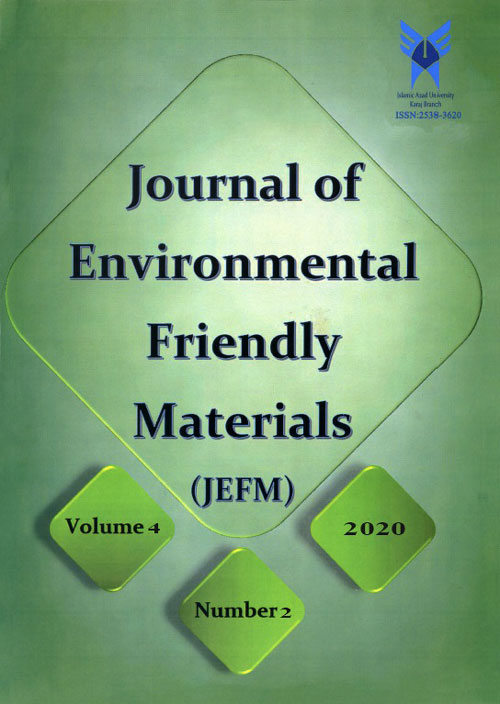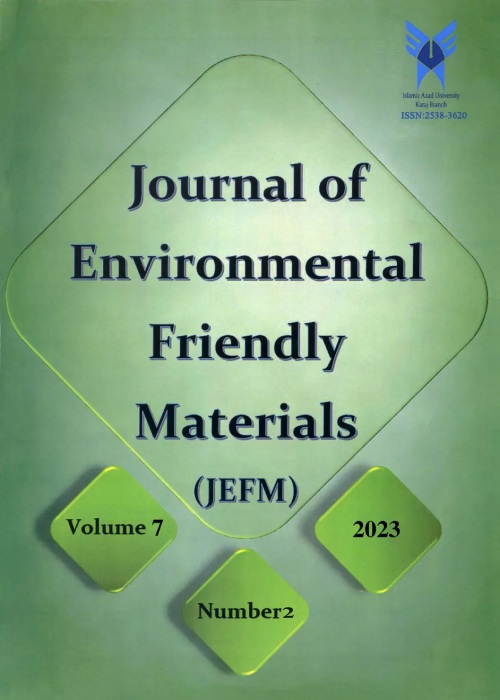فهرست مطالب

Journal of Environmental Friendly Materials
Volume:4 Issue: 2, Summer-Autumn 2020
- تاریخ انتشار: 1399/09/29
- تعداد عناوین: 8
-
Pages 1-8
High Entropy Alloys(HAEs) are alloys with multiple elements (typically 5 or more elements) that remain in solid solution state instead of precipitate in several phases. These alloys are multicomponent alloys having constituents in equiatomic or near equiatomic ratios (having the atomic percentage between 5% and 35%). In this paper, the effects of Ta addition on the microstructure and oxidation behavior of 4 High and Medium Entropy Alloys were investigated with the aim of understanding the relationship between phase / microstructure and oxidation resistance of AlCrCoNiY-xTa alloys. The microstructure investigations showed that the presence of Ta alloying element could lead to the formation of CrTaO4 phase. The amount of this phase increases with a higher percentage of Ta element. Also, more results show that, formation of CrTaO4 phase facilitates the formation of Al2O3 oxide phase as an outer layer and the presence of this phase can improve the oxidation properties of the investigated alloys
Keywords: High-Entropy Alloys, Oxidation Resistance, CrTaO4 -
Pages 9-19
In this research, the effect of heat treatment on the microstructure and mechanical properties of intermetallic compounds of welding joint interface of three explosive layers of 5083 and 1050 aluminum as flying and intermediary plates and AISI steel sheet as the base plate has been discussed and investigated. To show the effect of temperature and time, the welded samples with stand-off distance of 6, 8, and 10mm and the explosive load of 2.41 were placed on heat treatment in the constant temperature of 315°C and 450°C within a furnace protected by Argon gas for six hours. Laboratory investigations have been conducted by the use of photomicroscope, scanning electronic microscopy, and microhardness assessing tests. Metal compounds of the interface were specified by the use of EDS analysis. In the considered samples before heat treatments, the interface of the joint has been converted from the short wavy state into the vertical wavy state by the increase of stand-off distance from 6 mm to 10 mm, and the average diameter of intermetallic layers has been increased in a range from 0.1±1.89 micrometer to 0.07± 3.13 micrometer as well. Also, microhardness has been decreased by the increase of intermetallic compounds from 266 Vickers in the sample with a stand-off distance of 10 mm to 205 Vickers in the sample with a stand-off distance of 8mm in the steel section. The performance of treatment in temperatures of 315°C and 450°C for six hours has been led to increasing the diameter of the intermetallic compounds layer.
Keywords: Heat treatment, Explosive Welding, intermetallic compounds, Stand-off Distance, Microhardness -
Pages 21-25
The simulation of heat distribution has long been applied for estimating optimal time for heat treatment process in an attempt to optimize the energy consumption. Aluminum alloys have been used to achieve appropriate strength-to-weight ratio and reduce the fuel consumption. In the present research, heat distribution modeling was performed for joining AA2024-T4 to AA6061-T6 in the TLP process utilizing MATALAB R2016b. For this purpose, thermal properties and density of the base alloys and the clamp were extracted from respective ASM standards and applied in the coding. Finally, 1D, and 2D simulations were run to simulate the heat distribution over the base metal at the process temperature. Moreover, the time required to have the copper diffused into the interlayer was estimated through the simulations. The diffusion depth of the Sn into the base metal (Al) was further modeled at different points in time. A Sn-2.5Bi interlayer with two different thicknesses (50 and 70 microns) was also evaluated through actual experiments.
Keywords: TLP, Modeling by MATLAB, AA2024-T4, Heat Distribution, Atomic Diffusion -
Pages 27-31
The operational temperature of a gas turbine blade made of IN738LC superalloy was investigated. The component under evaluation was a first stage blade of a 25MW power plant gas turbine with the gas temperature of 943 in the first stage nozzle at the base load. The evaluation was carried out after 16000 h of operation in the mode of base load. To analyze the temperature distribution of the component, three 3D-models of the blade were prepared, meshed and analyzed using CFD software. The results indicate the higher temperatures in the upper section of the leading edge during steady state operation of the blade.To evaluate the reliability of this analysis, intermetallic coarsening behavior was examined as the most important microstructural changes of the alloy after long term service exposure. This metallographic analysis also approves increasing in temperature with height of the airfoil section.
Keywords: gas turbine, IN738LC Superalloy, Gamma Prime Coarsening -
Pages 33-37
Nanostructured molybdenum trioxide (MoO3) films as environmental friendly materials can be used in various filed such as electrochemical energy storage devices, rechargeable batteries and gas sensors. In this work, nanostructured MoO3 thin films were successfully grown on quartz substrates by two-step method. In the first step, molybdenum films were deposited on quartz substrates by DC magnetron sputtering technique. Then the plasma oxidation of molybdenum films was used to prepare molybdenum oxide. The effect of plasma oxidation power and thermal annealing on the structural, morphological and optical properties of the MoO3 films were investigated by different analysis including XRD, AFM, RBS and spectrophotometry. XRD results indicated that the plasma powers effectively influenced the structure of films. The RBS analysis confirmed the presence of Mo and O elements. The AFM images showed that an increment of plasma power leads to decrease the roughness of films and annealing effectively changed the morphology of films. Furthermore, the optical transmittance decreases by increment of the plasma oxidation powers.
Keywords: MoO3, Plasma Oxidation, Thin Film, Sputtering, Nanostructure -
Pages 39-45
Rolling is a common method for production of metallic parts in various shapes and sizes. In this method, the raw material placed between two rigid rolls until take the shape and size. There are two rolling methods, hot rolling and cold rolling. To achieve higher mechanical properties, and better surface quality and dimensional accuracy, the hot rolled sheets undergo the cold rolling process. The friction between the metal and rolls affects the forming process, increase the required load for forming, reduce the surface quality and increase the wear of tools. The simulation of rolling process will be helpful to improve the forming procedure and quality of products. In this research, the Finite Element method is used to model, simulate and analysis the rolling process of St 37 steel sheets in sticky friction plane strain conditions. Because of stress strain behavior of material during the forming process and increase of frictional stress due to forming process, the analysis of forming load between the contact surface of rolls and sheet are shown by simulation. Finally, simulation of forging process as a friendly tool can reduce the scrap rate, tools wear and environmental effects of scraps.
Keywords: Cold Rolling, Sheet Rolling, Simulation, Friction, rolling force -
Pages 47-51
The aim of this investigation was to audit and assess the energy consumption and energy efficiency of casting process in an aluminum sand casting foundry. Energy measurements took place by meter readings, on daily and weekly basis and by half hourly electricity readings provided by the supplier. At the same time all foundry operations were monitored closely to follow variables with the help and explanation of operators and the managers. The yield was also measured by dividing the final weight of castings with the input weight of the material. Data analysis took place through calculating and comparing the energy consumption of the foundry on a daily and weekly basis. Observations and calculations suggest that for this foundry energy efficiency can be increased and cost of production may reduce by adjusting daily production to a minimum of 300 kg of finished product per day. This study also shows further energy saving is possible by management control and personnel awareness, changing the foundry layout and speeding the casting operation to avoid delays, insulating furnace walls and covering the top when the furnace is not in use and keeping furnace temperatures as low as possible during melting and holding and avoiding unnecessary holding overnight and at weekends. The yield within the foundry varied from 40% to 55%. Casting operation can improve to higher yield of about 55% if simulation used more often to its full capacity with potential material and further energy saving.
Keywords: Aluminium, Sand Casting, Foundry, energy, Cost -
Pages 53-61
The implant's metal base is not considered a foreign body when placed inside the jawbone and is compatible with the patient's jaw environment. This is due to its non-magnetic properties and high resistance to oxygen, acidic compounds, and salt. The implant’s structure and the surface will also affect the interaction between the metal and living tissues. One of the main reasons for the implant’s surface changes is the reduction of coalescing time and their integration with the jawbone. Since strong bone formation is crucial in dental implants treatment, with this operation, the bone formation in the pores of the fixture is done better, and the fixture fuses more to the bone. Implant surface coating increases bone deposition on the implant, which includes: mechanical changes (machining or sandblasting), chemical changes (acid pickling), electrochemical changes (anodic oxidation), vacuum changes, and heat or laser treatments. These changes control the growth and metabolic activities of bone cells. In this study, a review of various implant treatment methods, including sandblasting (SLA) and sandblasting with acid washing (SLActive), has been performed. Finally, it was concluded that SLA, SLActive, and HA surface treatment methods bind to the patient's jawbone faster than other methods in post-surgery weeks. In the meantime, the adsorption rate of the implant to the bone in the SLActive process compared to the SLA method increases by about 20 to 22% in the period of two to eight weeks after surgery, which is due to the integration speed of this method.
Keywords: Implant Prosthesis, Implant Titanium Surface Treatment, SLA, SLActive


